Early morning inspiration...
I am fortunate to be able to spend a few months each year on a small island in the lower Bay of Fundy in eastern Canada. (Some would say I'm "lucky", but luck has nothing to do with it.)
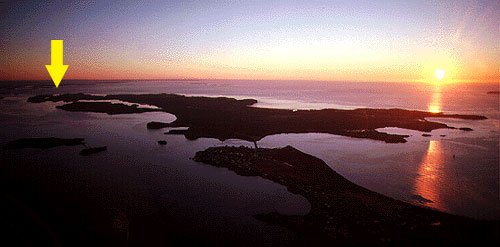 Our home is almost at the northern tip of this 9 mile x 3 mile island, which narrows down to a 50 yard-wide peninsula topped by the Head Harbour Lightstation, a scenic lighthouse with 270 degree views of the surrounding bays. The lighthouse is a popular destination for tourists, lighthouse aficionados (of which there are many), and my dogs.
Our home is almost at the northern tip of this 9 mile x 3 mile island, which narrows down to a 50 yard-wide peninsula topped by the Head Harbour Lightstation, a scenic lighthouse with 270 degree views of the surrounding bays. The lighthouse is a popular destination for tourists, lighthouse aficionados (of which there are many), and my dogs.
Dawn arrives early here, somewhere around 4:15 AM. That's Eastern daylight time, which we choose to stay on rather than move the clock ahead an hour to the proper Atlantic time in which we actually live. We can see the Eastern time zone in Eastport, Maine, across the bay, so it's no big deal either way... but always a minor source of confusion and calculation when arranging dinner times with neighbors or whale-watch boat reservations. "Island time or American time?"
In any case, whether it's 4:15 or 5:15 AM, our dogs start to stir when the sky begins to brighten. They all sleep in our bedroom on their own beds, so even though we take their "jingles" (collars with noisy tags) off before we go to bed, I still hear them when they start to rustle. Usually because I've been awake for a while anyway.
So our morning drill is for me to get up, turn on the coffee pot that's been readied the evening prior, put their jingles back on and let them outside. Once proper ablutions have been performed, they run back to the house for their breakfast, bowls also filled the night before. I pour a cup of coffee and wander over to my laptop on the dining table, which looks out over the early morning skies. I start to go through my email to the raucous symphony of jingles against bowls, at least for the 15 seconds it takes for two of the three (those with all or some Golden Retriever genes) to suck down their food.
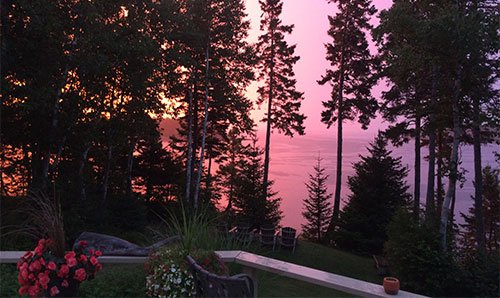
After about half an hour, they've had enough waiting around and start to congregate around me. One rubs against my legs, another sits and stares, the third whines. Time to go for our walk.
One rubs against my legs, another sits and stares, the third whines. Time to go for our walk.
While it would be easy to consider this an annoyance — and I do, occasionally if the weather is foul — I actually appreciate it as a nudge to get outdoors and enjoy the wonders of that early morning walk to the lighthouse. And this epitomizes the old saying of "it's a journey, not a destination".
The lighthouse at the end of the island is only a quarter-mile away, but often takes us fifteen minutes or more to get there. Between stopping to sniff (both them and me, at different things), squatting or lifting a leg (them, not me), we take our time. It's not a race.
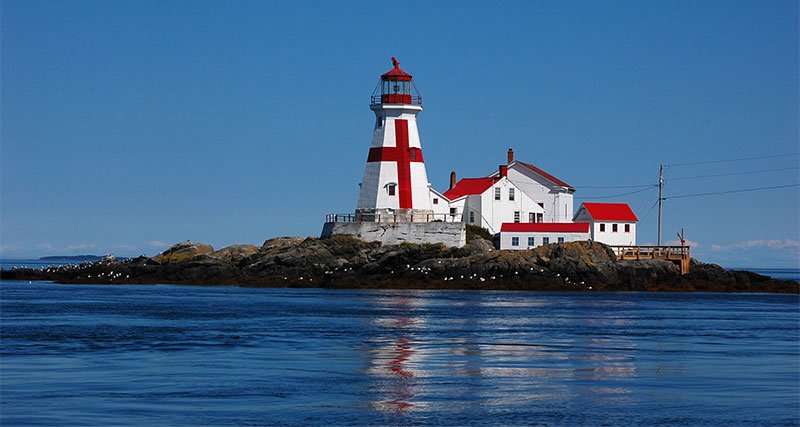
I try to take my cue from Paul Mac and be mindful, fully present, immersed in observation on these walks. If you allow it, a multitude of sights, sounds and smells presents themselves.
It rained all day yesterday so there was a lingering humidity in the air this morning. This tends to intensify the fragrances of spruce, balsam, moss, salt water, rockweed, Rosa rugosa or Rosa virginiana... which occasionally amalgamate into what we call "the Smell", a unique, almost intoxicating combination fragrance that's unique and indigenous to the coast of Maine and the Maritimes.
if one pays attention, pockets of specific fragrances become apparent. My wife's favorite (even though she's still sound asleep in bed) is the smell of balsam fir (Abies balsamea), which can almost make you dizzy as you walk through it, or stop to enjoy and breathe deeply, through the nose. I wish I could embed a scratch-n-sniff patch here.
I have counted as many as eight different predominant fragrances on our way to the lighthouse. But you'll miss them if your mind is elsewhere.
This particular morning, the sun was just a tad above the horizon and an intense orange in color, casting a long, equally intense reflection on the water. This is fleeting, as within a matter of minutes the color can fade as the sun rises higher, or can disappear altogether if there are striations of clouds in the sky. We walk right toward it, but it still begs a pause in our journey.

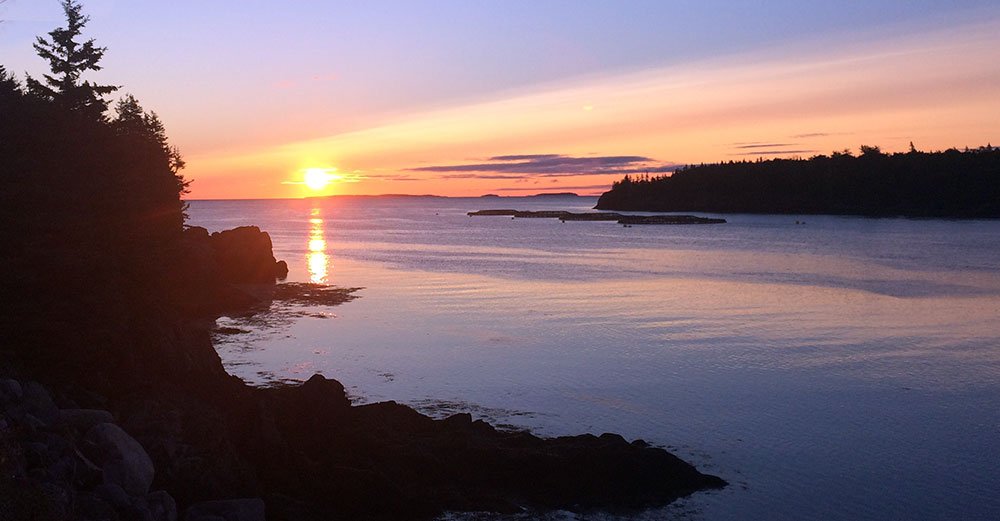
Which brings me to the sounds, the third component of this sensory extravaganza. A series of "we-eeps" in the trees alerted me to a group of eight or ten goldfinches flitting about. My favorite bird song here is "Oh-sweet-Canada-Canada-Canada" of the white-throated sparrow, a bird which I hear frequently but have never seen. They are always in the treetops somewhere. Then there's the ding-dong of the ubiquitous black-capped chickadee.
Down the road a ways comes the caw-caw-caw of a group of large crows. A croak from the tidal flats to the left alerts me to a blue heron, standing in wait for his next meal to swim by. The impatient shrieks of a juvenile bald eagle — one of two born back in April in the nest up in one of the black spruces that we pass — is echoed by the staccato cry of one of his parents, probably saying, "You're big enough to start getting your own breakfast". They are usually perched at the very top of one of the spruces. I've often wondered how a 20-lb bird can do that.
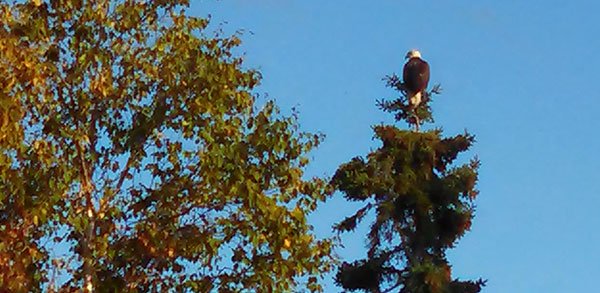
Intermingled with all this are the familiar calls of the herring gulls, the honk-honk of (what I think is) the black-backed gull, and the occasional osprey mimicking a bald eagle.
A lone mourning dove perched quietly on an overhead wire this morning, and a solitary cormorant paddled in the water.
Many mornings this summer I've heard finback whales spouting, sometimes very close by. It's particularly eerie when it's foggy. You can hear 'em but you can't see 'em. Either way it's pretty cool.
If the wind is blowing from the west and it's close to low tide, I can often hear the wailing of seals (gray and harbor) from the colony on the north end of a small out-island just offshore.
Then there are the wildflowers, adding visual and aromatic texture to the roadsides. The lupines are done by this time of year, but swards of fireweed (often mistaken for purple loosestrife by those who just give them a quick glance) provide masses of color. Indian paintbrush, black knapweed (with a flower similar to Canada thistle and favored by monarch butterflies), ox-eye daisies, Angelica, wild asters, and the low-growing bunchberry (in the dogwood family, believe it or not) are either obvious or require some looking, but they're there, often adorning or framing a lowly guardrail along the road.
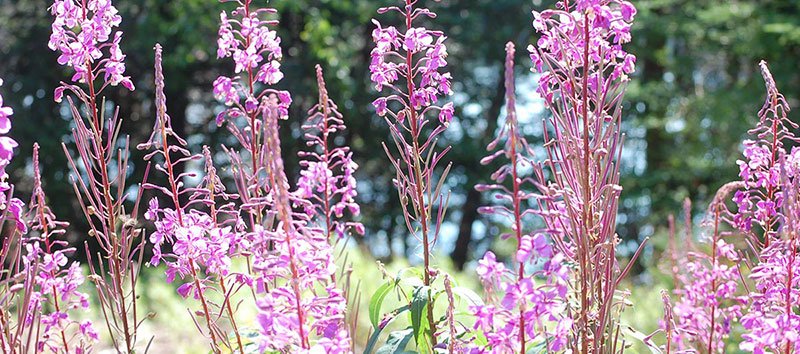
Above, the opportunistic fireweed, the provincial flower of the Yukon. Below, ox-eye daisies and Rosa virginiana along the roadside.
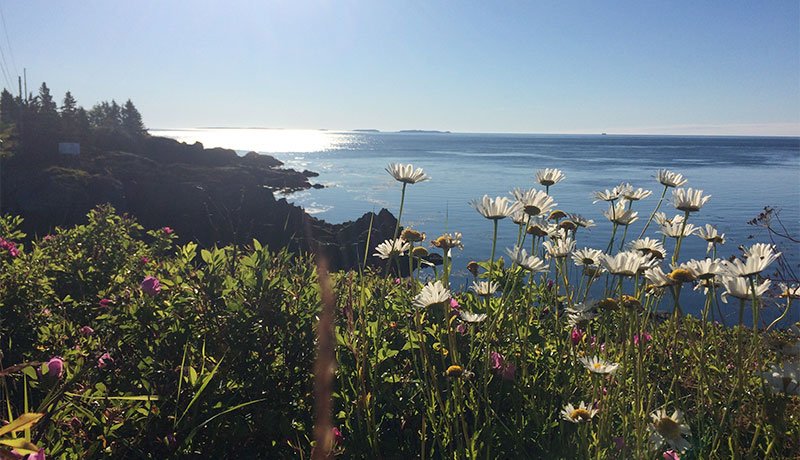
Those seeking McDonalds, amusement parks or miniature golf may say there's nothing happening on this little island, just the other side of the easternmost town in the continental US. But I disagree. There's plenty going on if you stop and observe. In some ways, though, the real beauty of such a place isn't what it is or has, but what it isn't or has not.
By the way, we do have a nice 9-hole Geoff Cornish-designed golf course on the island, part of the provincial park.
Most golf course superintendents hop in the golf car or utility vehicle for their morning ride to inspect the course, for the sake of expediency. Some prefer to walk, however. I believe Chris Tritabaugh at Hazeltine walks his morning rounds. It surely takes longer, but my bet is that the quality of observation is greatly enhanced.
In our own ways, we're all fortunate. Not lucky... but fortunate.


3 Comments
Recommended Comments